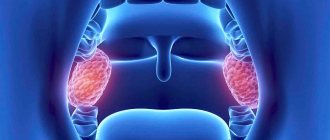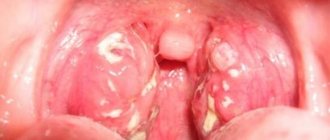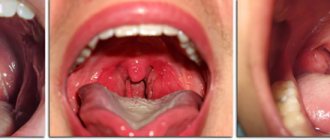What is the reason for this difference in approaches in the practice of Russian doctors and their colleagues from other countries?
First of all, the criteria on the basis of which the diagnosis of chronic tonsillitis is made are very different. In Russian medical practice, this diagnosis is often made based on an examination of the throat, even without assessing the patient’s history. In the practice of doctors from European countries, Japan, and the USA, such a diagnosis is rarely made, and based on a number of signs.
Patients who have been diagnosed with this can often hear about a “locus of chronic infection”, the risk of developing other diseases due to the fact that dangerous bacteria spread from the palatine tonsils to other organs and systems. Today this medical concept is outdated. Numerous studies and meta-studies have shown that only one disease has a risk of spreading beyond the tonsils - tonsillitis or, in scientific terms, “streptococcal acute tonsillitis”.
Sore throat is a disease caused by certain bacteria that are easily transmitted from person to person. If a patient suffers from tonsillitis more than 2-3 times a year for several years, the tonsils need to be removed. This is the only measure that, from the standpoint of modern science, can help the patient in this situation and negate the risks of developing other diseases.
Rinsing the tonsils does not reduce the risk of developing tonsillitis.
Methods for washing tonsils: which one to choose?
Washing the tonsils is, of course, not a surgical operation, but it should be performed by an otolaryngologist. In no case should you try to do this yourself or with the help of relatives, since if done incorrectly, you can not only not eliminate the symptoms of chronic tonsillitis, but also “drive” the disease deeper - then it will be difficult for the doctor to cope with the consequences. In addition, you can unknowingly injure the palate and the tonsils themselves.
The two most common methods of washing the lacunae of the palatine tonsils today are with a syringe and a device that combines the effects of ultrasound and vacuum. Which method is preferable?
Flushing with a syringe. In a regular district clinic, the patient will most likely be offered to rinse the tonsils with a syringe. A cannula is attached to it (a special brass rod with a replaceable tip). The patient is required to sit for a while with his mouth open to gain access to the infected tonsils.
Before starting the procedure, the surface of the larynx is treated with an anesthetic (lidocaine) - this will reduce the discomfort. In general, the procedure is considered painless and lasts about 10 minutes. During its implementation, liquid is pumped out from the cavities of the tonsils, purulent plugs, small pieces of stuck food, pathogenic microbes and the remains of their vital activity are cleansed. At the same time, the surface of the pharynx and lacunae are irrigated with special solutions that help stop inflammatory processes.
Washing the tonsils using the vacuum method. Recently, the second method of washing the tonsils has been increasingly used - with a vacuum apparatus called “Tonsilor”. It works like a kind of micro-vacuum cleaner, sucking out the pathogenic contents of the lacunae, freeing and cleaning them. Rinsing the tonsils with Tonsilor uses ultrasound, which effectively extinguishes inflammation, has analgesic properties, and helps the fluid actively penetrate into the tissue.
Why then wash the tonsils?
Usually the reason for washing is the so-called “plugs” or tonsillitis. Among patients and, unfortunately, often among doctors, there is a belief that these “traffic jams” are manifestations of a chronic infection. Sometimes you can hear the term “purulent plugs”. This description is incorrect. Indeed, in the lacunae (pores) of the palatine tonsils, food debris, calcium salts, dead and obsolete cells of the palatine tonsils and bacteria that normally live in the oral cavity sometimes accumulate. Together they form a white conglomerate, usually dense. Tonsilloliths themselves are not a sign of any disease. In the event that they physically interfere with the patient, as a rule, proper independent care of the oral cavity and teeth is sufficient.
When should you wash your tonsils?
The fact is that pathogenic microorganisms and dead leukocytes not only accumulate inside the tonsils, but they also cannot leave their location, since inside the tonsils there are many voids and tortuous “passages”. If you influence them with the same drug, then sooner or later addiction occurs - microorganisms (streptococci and staphylococci) become resistant, adapt to the antibiotic, and it is no longer powerless to cope with them. This is where a special procedure comes to the rescue - washing the tonsils.
Washing the tonsils is prescribed to a person who has long suffered from chronic tonsillitis with constant exacerbations, who feels constant weakness, soreness in the throat, in the cervical and submandibular lymph nodes.
What to do if your throat constantly hurts? Is this an infection?
No, persistent sore throat is most often caused by non-infectious causes. The most common cause is acid from the stomach entering the back of the throat through the esophagus. This condition is medically called gastroesophageal, or extraesophageal, reflux. This is a very common illness that can occur without abdominal pain or heartburn. If heartburn occurs constantly and your throat often hurts, then the connection between these events is obvious and you need to deal with this particular problem, and not try to cure your throat.
What are the indications for adenoid removal (adenotomy)?
Adenotomy
More details
- Poor nasal breathing during the period when the child is healthy. This is dangerous because the child’s body experiences hypoxia (oxygen starvation). Insufficient oxygen supply to the body can lead to a delay in the psychomotor development of the child; the child may be adynamic, or, conversely, hyperactive. Due to the fact that the child constantly breathes through his mouth, the facial skeleton (adenoid face) is formed incorrectly. The quality of life of such children certainly suffers.
- Hearing loss or frequent inflammation in the ears are also direct indications for adenotomy. The mechanism of occurrence of this pathology occurs as follows. Where the adenoids are located, there is the mouth of the auditory tube (Eustachian tube) - an organ that connects the middle ear (what is located behind the membrane) and the nasopharynx itself. If, with your mouth closed, you pinch the tip of your nose and exhale into your nose, then air will enter your ears due to this very organ. Due to the close anatomical location of the adenoids and the auditory tubes, the inflammatory process from the adenoids can move to the mouth of the auditory tubes, causing in turn inflammation and, as a consequence, dysfunction of the auditory tube. In addition to the chronic inflammatory process in the auditory tubes, when adenoids grow, they can cover the mouths of the auditory tubes, leading to the development of adhesive otitis media or the formation of exudative otitis media (fluid in the middle ear). Frequent purulent-inflammatory phenomena in the cavity of the middle ear (sound transmitting apparatus) lead to the formation of adhesions and scars between the auditory ossicles, which subsequently leads to hearing loss in adulthood. In these cases, between the organ of hearing and the natural filter in the form of adenoids, we choose the organ of hearing.
- It is also necessary to part with adenoids if the child often suffers from adenoiditis, which, with local treatment, does not produce significant positive dynamics, but only leads to recovery for a short period of time. This is a consequence of the fact that the adenoids do not carry out their immune function, they have worn out themselves as a natural filter, are a source of chronic infection and need to be sanitized (removed). Adenoiditis can also often be associated with herpes viral infection (Epstein-Barr virus, cytomegalovirus, type 6 virus), which live in the lymphoid tissue, leading to a decrease in immunity, including local immunity. If your child suffers from ARVI more than 6 times a year, there is cervical lymphadenitis (enlarged lymph nodes), conservative treatment of adenoiditis helps for a short time, in this case you need to contact a pediatrician for further examination for a herpes viral infection. When this group of viruses is detected, adequate treatment is prescribed, and if positive dynamics are observed in the adenoids during therapy, the child should be observed and there is no need to rush into surgery.
But if, together with treatment from a pediatrician, no effect is observed, then, according to the law of surgery, the tissue that prevents a person from living is removed.
Using the Tonsillor device
You can use the device if you have the following examination results:
- examination by a doctor;
- blood test data;
- urine test indicators. The results are necessary to exclude possible pathological conditions of patients during the procedure.
The device operates in two directions:
- Ultrasound radiation “grinds” plugs in gaps;
- The vacuum nozzle carefully sucks out the crushed contents.
The advantages of sessions are painlessness, cleaning efficiency, there are practically no contraindications, minimal time costs.
There can be several procedures using Tonzillor, one per week.
Restoration of the tonsils occurs as follows:
- the tonsils are treated with an anesthetic;
- the vacuum nozzle is installed on the gaps;
- simultaneously with the antiseptic solution supplied to the recesses, an ultrasound effect occurs;
- vacuum removes all contents in them.
Vacuum rinsing of tonsils - a fashionable procedure or the last way to avoid surgery?
Practicing ENT doctors believe that a course of washing the tonsils, consisting of at least ten consecutive procedures, can radically improve the patient’s condition, and possibly save him from the need for surgical intervention. The main conditions that ensure the result are the timeliness of the procedures (compensated and subcompensated stage of chronic tonsillitis) and the effectiveness of the technique.
Classical rinsing of the tonsils is carried out using a special syringe with a curved cannula. The spout through which the solution is supplied is directed directly into the “pocket” filled with purulent contents. The disinfectant solution is supplied under pressure and washes the contents out of the gaps. The disadvantage of this method is its potential for trauma to delicate lymphoid tissue and the inability to wash small depressions.
Vacuum rinsing of the tonsils is carried out using a special device, which, in addition to supplying a medicinal solution under high pressure, provides vacuum aspiration of the contents of the lacunae. This allows you to clean “pockets” of any size, and most importantly, it saves you from the need to come into close contact with the tonsil, and therefore does not damage it. In addition to vacuum aspiration, the new technique involves ultrasonic treatment of tissue, which facilitates the rapid removal of plugs of any size and consistency.
Cauterization methods
| Method | What is used | Advantages | Flaws |
| Cryotherapy | A liquid nitrogen. Under the influence of liquid nitrogen, the tissue is greatly cooled. Ice crystals form inside the cells, destroying the cell wall. | Bloodless, painless method. Well tolerated by elderly patients. | To achieve a lasting effect, a course of procedures is required. |
| Laser ablation | CO2 laser, holminium or fiber optic laser. The effect is based on the evaporation of liquid (coagulation) of tissue due to laser heating. | Bloodless, painless method. | Heating of the tissues surrounding the tonsil, the formation of a layer of dead tissue, which disappears within 5-7 days. Within 2-3 days after the procedure, discomfort in the throat, similar to a cold. |
| Radio wave ablation | Alternating high-frequency current (radiosurgery devices Surgitron, Curis). The effect is achieved by heating the tissue and evaporating liquid from it. | Bloodless, painless method, good wound healing, gentle effect on surrounding tissues. The procedure is carried out once, and can be repeated after several years. | The formation of a layer of dead tissue, which disappears within 5-7 days; the next day after the procedure, discomfort in the throat, similar to a cold. |
Treatment
Treatment of inflammation of the tonsils can be either conservative or surgical. Conservative therapy for inflammation of the tonsils includes:
- physiotherapeutic treatment
- prescribing a course of systemic antibiotics;
- symptomatic treatment;
- immunomodulatory and restorative drugs;
- treatment using the Tonsillor device.
- In case of ineffectiveness of conservative treatment and the development of serious complications, a decision is made on surgical intervention. Removal of tonsils for chronic tonsillitis is called tonsillectomy or tonsillotomy.
Contraindications
It is also necessary to take into account a number of contraindications to such a procedure. These include:
- ENT diseases in the acute stage (including acute tonsillitis);
- influenza, ARVI and other viral diseases;
- acute form of tuberculosis;
- negative reaction of the body to ozone;
- malignant neoplasms of any location;
- hypertension 3 degrees;
- blood clotting disorder;
- first trimester and last month of pregnancy.
Advantages of this method
The use of the "Tonsillor" device has a more gentle effect on the tonsils compared to mechanical cleaning. And thanks to the special design of the attachments, the doctor is able to reach the most inaccessible places without the risk of injuring the tissues of the oral cavity or causing serious discomfort to the patient.
The procedure is absolutely painless, as it is performed using an anesthetic and takes no more than 10 minutes.
Frequently asked questions related to the procedure
- How many treatments are needed? To get rid of tonsillitis you need to undergo 5-10 procedures. The specific number is determined by the doctor depending on the extent of the inflammatory process.
- Is pain relief provided? Although irrigation is carried out without a needle, local anesthesia is still used. They do this to reduce discomfort during manipulation.
- How to prepare for the procedure? Preparation consists of refusing to eat at least an hour before the upcoming wash.
- How often should you rinse your tonsils? The need for the procedure depends on the activity of the disease and the rate of accumulation of fluid, food particles, and bacteria in the lacunae. Only the attending physician can determine the frequency of washing. At least once a day.
- How long should I rinse my tonsils? Even if during a single procedure it was possible to completely remove the contents of the lacunae, the manipulation will have to be repeated at least 7-10 more times, it is better to do it every day. This is due to the constant proliferation of pathogenic microflora. And this approach will allow you to achieve stable remission.
- Are there any special features of oral hygiene during the course of treatment? During the course of treatment after each procedure, it is prohibited to eat for the first two hours. It is also worth giving up solid food during this period, since after eating it, a piece may get stuck in the passages.
Thus, washing the tonsils for tonsillitis is an effective treatment method. But if carried out incorrectly, a serious complication can develop, so it is better to contact a specialist.
Causes
The etiology and pathogenesis of chronic tonsillitis has not been fully studied to date.
The starting mechanism in the development of chronic tonsillitis is repeated inflammatory processes leading to local immunosuppression.
- Local causes are infectious foci (carious teeth, purulent sinusitis, etc.).
- Pathogenic and opportunistic microorganisms.
- Immunodeficiency states.
- Persistent violation of nasal breathing (adenoids in children, deviated nasal septum, etc.).
- Allergic sensitization of the body.
Chronic tonsillitis
Your child is undergoing surgery. We would like to give you and your child information about the need for this intervention. We make sure that you do not feel helpless in this situation. We would like to acquaint you with the essential aspects of the operation itself, and the risk factors in case of its failure. The written information provided to you serves this purpose. Read it carefully to discuss any unclear points with your doctor.
Every healthy child has lymphoid tissue in the pharynx, which is united into the so-called lymphadenoid pharyngeal ring. It includes the palatine tonsils - “tonsils” - they can be seen when examining the mouth - they look like balls protruding on the sides of the tongue, the pharyngeal tonsil - it cannot be seen during a direct examination of the oral cavity, it hides in the nasopharynx, behind the palate, lingual tonsil - located at the root of the tongue, and many lymphoid follicles scattered along the back wall of the pharynx, at the entrance to the larynx (see Fig. 18). These formations help the child defeat pathogenic bacteria that enter the throat during breathing and eating, and contribute to the formation of local immunity - protection against pathogens. By the way, in these organs there are no cells that affect the sexual development of the child, they do not produce sex hormones, therefore their diseases do not affect the sexual development of the child, and if they are removed if necessary (more on this later), sexual development is not disrupted.
In early childhood - usually from 2 to 5-7 years - the described organs work very hard, as the child expands the scope of contacts with peers by attending kindergarten, and inevitably often becomes infected and develops respiratory diseases. Moreover, if the child’s immune forces are not strong enough due to congenital characteristics, environmental factors and other reasons, the lymphoid organs increase in volume. This enlargement of the palatine tonsils is called “hypertrophy of the palatine tonsils”; they can become inflamed - inflammation of the tonsils is called tonsillitis. Tonsillitis can be acute or chronic. In children, chronic tonsillitis and adenoids - an enlarged pharyngeal tonsil - are often combined.
The tonsils of the pharynx have a significant impact on the state of health and the development of nearby organs. What kind of influence is this? A noticeable obstruction to the passage of air through the nose leads to breathing through the mouth. The consequence is obvious - untreated air enters the respiratory tract - not purified, not warmed and not humidified. A chronic inflammatory process, constantly smoldering in the tissue of the tonsils and adenoids, periodically exacerbating, contributes to protracted, recurrent diseases of the trachea and bronchi (bronchitis, obstructive bronchitis, tracheitis, pharyngitis), can independently cause or aggravate the course of allergies, in severe cases manifested in the form of bronchial asthma , allergic rhinopathy, atopic dermatitis. Adenoids and enlarged palatine tonsils, filling the pharynx, impair the functioning of the auditory tubes, which cannot supply sufficient air to the middle ear, as a result of which secretory otitis media develops, which can lead to hearing loss, and if infection enters the ear, to its acute inflammation – acute purulent otitis media. Poor breathing through the nose contributes to improper development of the maxillofacial area - the bite of the teeth is disrupted, the shape of the face changes (the so-called “adenoid face”).
The causative agents of infectious diseases of the respiratory tract (most often streptococci) after a sore throat remain in the palatine tonsils, and their chronic inflammation develops - chronic tonsillitis. Under unfavorable circumstances (hypothermia, stress, viral infection), the process in the tonsils is activated. This occurs in the form of another sore throat with plaque on the tonsils or purulent plugs. What is very dangerous is that each exacerbation of tonsillitis can cause complications in the form of diseases of other organs and systems of the child’s body, most often rheumatic diseases of the heart and joints, kidney diseases (pyelitis, pyelonephritis, glomerulonephritis). In addition, exacerbation of tonsillitis or tonsillitis sometimes causes complications in the form of an abscess (ulcer) in the pharynx. This complication is called peritonsillar abscess. A peritonsillar abscess indicates that the palatine tonsil is unable to cope with its function; it can recur at any time.
What factors contribute to enlargement of the pharyngeal tonsils and the development of chronic tonsillitis?
- Heredity - at least if the parents suffered from adenoids or tonsillitis, the child, to one degree or another, will also face this problem.
- Inflammatory diseases of the nose, throat, pharynx - and respiratory viral infections, and measles, and whooping cough, and scarlet fever, and tonsillitis, etc.
- Eating disorders - especially overfeeding.
- Tendency to allergic reactions, congenital and acquired immunity deficiency.
- Violations of the optimal properties of the air that the child breathes - very warm, very dry, a lot of dust, an admixture of harmful substances (ecological conditions, excess household chemicals).
- Inadequate (incorrect) treatment of acute tonsillitis (tonsillitis). The most common mistakes are an incomplete course of antibiotic treatment, incorrect dosing, violation of the therapeutic and protective regime (early getting out of bed, walking outside before 7-10 days from the start of treatment).
Thus, the actions of parents aimed at preventing chronic tonsillitis come down to correction, and even better, to the initial organization of a lifestyle that promotes the normal functioning of the immune system - feeding according to appetite, physical activity, hardening, limiting contact with dust and household chemicals.
What is the difference between chronic tonsillitis and tonsil hypertrophy?
Hypertrophy of the tonsils is an increase in their size in the age of a child up to 9-10 years. With chronic tonsillitis, the tonsils can be of any size; its distinctive feature is the development of a chronic inflammatory process in the tonsils.
What if a child, along with chronic tonsillitis or enlarged tonsils, has adenoids?
The presence of adenoids and difficulty in nasal breathing significantly influence the development of tonsil disease. In this case, otolaryngologists suggest that in the case of a compensated form of tonsillitis, while preserving the palatine tonsils, it is necessary to remove the adenoids, and in the case of a decompensated form, include adenotomy in the scope of the operation to remove the palatine tonsils, which slightly lengthens the operation and is almost imperceptible to the patient, but greatly affects the result of the operation. If this is not done, the child has a high probability of progression of tonsillitis or adenoiditis, which will negate the results of tonsillectomy - difficult nasal breathing will persist, the child will again become ill often, snoring will not go away or will worsen.
When is tonsillitis treated and when is surgery performed?
There are two forms of chronic tonsillitis: compensated and decompensated. In the decompensated form, surgical treatment is not possible - the tonsils must be removed. This diagnosis is made when tonsillitis often worsens (2-3 sore throats per year), the process extends beyond the tonsils, if diseases of distant organs and systems develop, for example, nephritis, rheumatic diseases of the heart and joints. Tonsils must be removed if a peritonsillar abscess develops.
Is it possible and necessary to treat chronic tonsillitis?
Let us emphasize that treatment is not only possible, but also necessary. Until the child develops the changes mentioned earlier, every six months, local treatment should be carried out in the form of irrigation of the pharyngeal mucosa with aqueous solutions that have anti-inflammatory, antiallergic and antimicrobial properties, as well as general treatment methods, including vitamin preparations, agents that affect immune system, locally acting vaccine preparations, physiotherapeutic methods (magnetic and laser therapy, inhalations). Otolaryngologists consider it particularly important in the treatment of tonsillitis to conduct a course of washing the lacunae of the palatine tonsils (7-10 procedures per course of treatment).
How urgently should the operation be performed?
The operation to remove the tonsils - tonsillectomy - is planned, that is, it is performed when the child is in full health or in remission of chronic diseases. It cannot be performed during acute illnesses (ARI) and 3-4 weeks after recovery. Thus, it is always possible to perform this operation in a period favorable for the child, which will minimize the risk of postoperative complications.
Do palatine tonsils grow again, are relapses possible?
No, completely removed tonsils cannot grow back.
How are tonsils removed?
This operation is performed using local or general anesthesia (narcosis). It lasts 25-30 minutes and, with proper psychological preparation of the child, is tolerated satisfactorily. The simplicity of the operation does not indicate its safety. Complications due to anesthesia, bleeding, and damage to the palate are also possible. But all this does not happen often.
Surgeons have long abandoned the removal of tonsils using ultrasound and laser due to the huge risk of complications.
How long does a child stay in the hospital after surgery?
Due to the high risk of bleeding in the postoperative period, the child is in the hospital for 6 days after surgery.
What should you do after your baby is discharged?
The child is discharged from the hospital under the supervision of an ENT doctor or pediatrician at the clinic at the place of residence. Home treatment is usually recommended for 1-2 weeks. In this case, physical activity should be limited, however, there is no need to keep the child in bed. When eating during the first days, you should not eat hot, spicy foods, sour juices and fruits, carbonated drinks, or ice cream. After 5-7 days, the diet becomes normal. 10-14 days after discharge, if the child’s general condition is satisfactory, there is no elevated body temperature, and the wound in the pharynx is healing smoothly, you can visit the children’s group and go outside. You can’t just do sports or go to the pool. The wound in the pharynx heals completely in 3-4 weeks. A month after the operation, there are no restrictions in lifestyle or diet.
How to remove tonsils at the Children's City ENT Center?
To establish a diagnosis, if there is no ENT doctor in the clinic, you can make an appointment at the city ENT consultation office by calling 2-78-49-00 (inquiry).
Reception is carried out on weekdays, from 8.00. until 20.00.
If the diagnosis of “chronic tonsillitis” has been established and you have made the decision to operate on your child, with a referral for surgical treatment issued at the clinic, you should go to the emergency department of the 3rd Children’s Clinical Hospital at any time convenient for you. Your child will be registered for hospitalization on the day you choose and will be given an examination plan (a list of tests necessary to perform the operation). Hospitalization is carried out on Tuesday and Thursday, from 13.00. until 15.00. and on Sunday from 16.00. until 18.00. The operation is carried out the next day.
What is rinsing the tonsils with the Tonsillor device?
This method combines three types of effects on the tonsils:
- Mechanical. Vacuum pressure helps expel purulent plugs from lacunae.
- Physiotherapeutic. Ultrasonic treatment of the affected lymphoid tissue disinfects, suppresses the activity of bacteria and other possible pathogenic microorganisms, and stops the inflammatory process. Ultrasound also improves blood flow to the ENT organs and microcirculation, which ensures deep penetration of the medicine into the tonsils.
- Medication. The use of saline solution or anesthetic serves to wash out purulent plugs. An antibiotic or glucocorticosteroid drug is then administered to combat local inflammation and infectious agents.
This combination of therapeutic effects, especially against the background of parallel drug therapy to strengthen the immune system, usually gives quick and long-term results.











